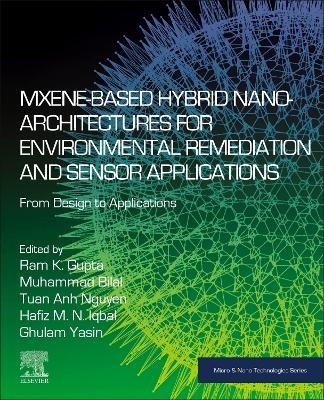
MXene-Based Hybrid Nano-Architectures for Environmental Remediation and Sensor Applications
Elsevier - Health Sciences Division (Verlag)
978-0-323-95515-7 (ISBN)
Dr. Ram Gupta is an Associate Professor of Chemistry at Pittsburg State University. He is the Director of Research at the National Institute for Materials Advancement (NIMA). Dr. Gupta has been recently named by Stanford University as being among the top 2% of research scientists worldwide. Before joining Pittsburg State University, he worked as an Assistant Research Professor at Missouri State University, Springfield, MO then as a Senior Research Scientist at North Carolina A&T State University, Greensboro, NC. Dr. Gupta’s research spans a range of subjects critical to current and future societal needs including: semiconducting materials & devices, biopolymers, flame-retardant polymers, green energy production & storage using nanostructured materials & conducting polymers, electrocatalysts, optoelectronics & photovoltaics devices, organic-inorganic heterojunctions for sensors, nanomagnetism, biocompatible nanofibers for tissue regeneration, scaffold & antibacterial applications, and bio-degradable metallic implants. Muhammad Bilal is working as an Associate Professor at the Faculty of Civil and Environmental Engineering, Gdansk University of Technology, Poland. Previously, he served as an assistant/associate Professor at Poznan University of Technology, Poland, and the School of Life Science and Food Engineering, Huaiyin Institute of Technology, Huaian, China. He earned his Ph.D. from Shanghai Jiao Tong University, specializing in bioengineering and applied biotechnology. His main research activities are oriented to Environmental biotechnology, nanotechnology, enzyme engineering, immobilization, chemical modifications, and industrial applications of microbial enzymes, liquid, and solid waste management. He has authored over 700 peer-reviewed articles, 150 book chapters, 25 edited books. Dr. Bilal is the associate editor of Frontiers in Chemical Engineering and Frontiers in Environmental Science (Frontiers), and an editorial board member for several journals. He was listed as a highly cited researcher (Clarivate) in 2021 and holds several "highly cited papers" in WOS. Hafiz M.N. Iqbal is a Research Professor in the School of Engineering and Sciences at the Tecnológico de Monterrey, Mexico. His areas of research are biomaterials, bioengineering, biomedical engineering, environmental engineering, bioremediation, bio-catalysis, enzymes, immobilization, chemical engineering, green chemistry, algal biotechnology, and bioenergy. Tuan Anh Nguyen is Senior Principal Research Scientist at the Institute for Tropical Technology, Vietnam Academy of Science and Technology, Vietnam. He received B.S. in Physics from Hanoi University in 1992, and Ph.D. in Chemistry from the Paris Diderot University (France) in 2003. He was Visiting Scientist at Seoul National University (South Korea, 2004) and University of Wollongong (Australia, 2005). He then worked as Postdoctoral Research Associate and Research Scientist in the Montana State University (USA), 2006-2009. In 2012, he was appointed as the Head of the Microanalysis Department at Institute for Tropical Technology. His research activities include smart sensors, smart networks, smart hospitals, smart cities and digital twins. He edited over 70 Elsevier, 12 CRC Press, 1 Springer, 1 RSC and 2 IGI Global books. He is Editor-In-Chief of "Kenkyu Journal of Nanotechnology & Nanoscience".
Section 1: MXenes in environmental applications
1. MXene-based hybrid nanoarchitectures: an introduction
2. Synthesis of element-doped MXenes and MXene-based hybrid nanomaterials
3. MXene-based hybrid nanomaterials for sequestration of radionuclides and toxic ions
4. MXene-based hybrid nanomaterials for efficient removal of toxic heavy metals
5. MXene-based nanomaterials for anticorrosion applications
6. MXene-based nanomaterials to remove toxic heavy metals
7. MXene-based hybrid nanomaterials for the removal of pharmaceutical-based pollutants
8. MXene-based hybrid nanomaterials in photocatalysis
9. MXene-based hybrid nanomaterials to remove toxic metals
10. MXenes for removal of pharmaceutical compounds from wastewater
11. MXenes for CO2 reduction: a promising choice
12. Removal of inorganic pollutants using MXene-based hybrid nanomaterials
Section 2: Mxenes in sensing applications
13. MXenes for sensors
14. MXenes based hybrid electrochemical sensors for cancer diagnostics
15. MXene-based hybrid nanomaterials for gas sensing applications
16. MXene-based hybrid biosensors
17. MXene-based electrochemical sensors
18. MXene-based hybrid nanostructures for strain sensors
19. Mxenes-based hybrid electrochemical sensors
Section 3: Mxenes in energy application
20. MXene for green energy: an introduction
21. MXene-based electrodes for hybrid supercapacitor devices
22. MXene-based hybrid nanomaterials for nitrogen reduction reaction
23. Challenges and future prospects of MXenes
| Erscheinungsdatum | 23.01.2024 |
|---|---|
| Reihe/Serie | Micro & Nano Technologies |
| Verlagsort | Philadelphia |
| Sprache | englisch |
| Maße | 191 x 235 mm |
| Gewicht | 1130 g |
| Themenwelt | Technik ► Elektrotechnik / Energietechnik |
| Technik ► Maschinenbau | |
| ISBN-10 | 0-323-95515-0 / 0323955150 |
| ISBN-13 | 978-0-323-95515-7 / 9780323955157 |
| Zustand | Neuware |
| Haben Sie eine Frage zum Produkt? |
aus dem Bereich


